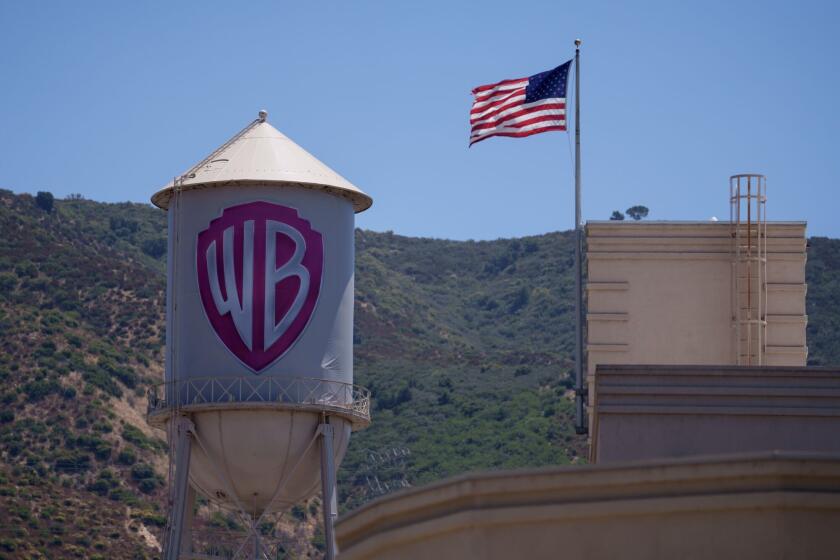What Netflix’s release of ‘Roma’ says about its movie business strategy

Nancy Garcia, Marina de Tavira and Yalitza Aparicio discuss working with Alfonso Cuarón on Netflix’s “Roma,” which won the top prize at the 2018 Venice Film Festival and is generating major awards season buzz.
- Share via
Alfonso Cuarón’s critically acclaimed film “Roma” — an intimate, black-and-white, Spanish-language feature about a middle-class Mexican family and their live-in nanny — seems an unlikely candidate for the role of Hollywood disrupter.
Nonetheless, the $15-million awards contender, which Netflix Inc. released in a handful of theaters just before Thanksgiving, has become a flashpoint in the contentious debate over the future of film distribution.
“Roma” was released in theaters three weeks before it becomes available to Netflix subscribers Dec. 14, an unprecedented move for a company that has traditionally eschewed the idea of releasing movies in theaters before they are available to subscribers on its streaming platform.
Facing rising competition from Walt Disney Co. and other media giants entering the streaming business, Netflix is increasingly eager to lure filmmakers who want their movies to be shown on a big screen and get awards recognition.
Awards pundits widely predict that “Roma” will earn the Los Gatos, Calif., company its first best picture Oscar nomination — a triumph for a company that craves the same credibility in the movie business that it has achieved in television, having become a fixture in the top Emmy races with such shows as “House of Cards” and “The Crown.”
But Netflix’s new film distribution strategy is facing heavy opposition. Many cinema chains are refusing to screen “Roma,” saying it sets a bad precedent.
It’s a battle that has pitted the exhibitors that built Hollywood against the powerful streaming giant that has radically disrupted its conventions.
The dispute revolves around a long-standing practice of releasing movies in ordered phases called windows. Traditionally, studios have waited 90 days after a movie opens in theaters before making it available for home viewing. Exhibitors argue that shortening the exclusive window from three months to three weeks devalues the theatrical experience and discourages people from leaving their homes to watch movies.
Every exhibitor should fight it. We should work with them, but work with them on terms acceptable to the exhibition community.
— Phil Zacheretti
“They’re still outsiders, and they’re still not part of our industry at this point,” said Phil Zacheretti, chief executive of Knoxville, Tenn.-based cinema chain Phoenix Theatres Entertainment. “Every exhibitor should fight it. We should work with them, but work with them on terms acceptable to the exhibition community.”
Netflix has been trying to walk a tightrope between its own competing interests, stirring internal tensions over how much to conform to — or upend — traditional cinema industry practices.
Chief Content Officer Ted Sarandos has long railed against the idea of windows as antiquated. He has insisted on releasing movies to streaming subscribers and in theaters simultaneously, arguing that doing so gives consumers more choice.
“We are not pro-theater, we’re not anti-theater — we’re pro-consumer,” he said at a May investors conference in New York. He reiterated that theme at an investor conference Monday, saying, “We’re trying to connect people with movies in a big, meaningful way.”
In the last year, Netflix has clearly softened its approach to cinemas. Netflix film head Scott Stuber, a former Universal Pictures executive, has pointedly assured top filmmakers their movies will get a robust theatrical push, people close to the company say. This summer, Netflix hired prominent awards consultant Lisa Taback to lead its campaigns, and has erected billboards along the Sunset Strip to remind voters of its titles.
Two film industry executives said Netflix is looking to build a small theatrical distribution team in-house, which would signal more of a willingness to pursue big releases. Netflix has considered buying a theater chain such as Landmark Theatres, but backed away from the idea because of the price.
Netflix declined to comment.

“BlacKkKlansman” director Spike Lee and “Roma” director Alfonso Cuaron lament the decline of cinema on the big screen.
The company has struggled to balance its aversion to windows with its need to attract talent — such as Cuarón, Joel and Ethan Coen and Martin Scorsese — as well as Oscar glory. Previous Oscar hopefuls “Beasts of No Nation” and “Mudbound” were released in some theaters simultaneously with their streaming debuts but failed to secure best picture nominations.
“No filmmaker says, ‘Yeah, I want to make a movie for an iPad.’ They want people to see it on the big screen, and rightly so,” said Karie Bible, a box office analyst with Exhibitor Relations. “In order for it to be taken seriously by the [motion picture] academy, it has to have a theatrical release.”
Rival Amazon Studios earned a best picture nod for its 2016 drama “Manchester by the Sea.” Amazon’s strategy is to work with theaters to give its movies a prolonged theatrical rollout before they become available on Amazon’s Prime Video streaming service.
To qualify for Oscars, movies must be shown in theaters before, or on the same day as, other distribution methods.
Beyond prestige, Oscar victories could attract more filmmakers to Netflix and encourage subscribers to watch its films.
When it announced the release plan for “Roma,” Netflix also promised limited exclusive theatrical windows for the Coen brothers’ “The Ballad of Buster Scruggs” and Susanne Bier’s thriller “Bird Box.” “Buster Scruggs,” a well-reviewed western anthology film, had a one-week exclusive window in a small number of cinemas.
Participant Media, which financed “Roma,” held talks with a number of potential distributors before deciding to partner with Netflix, swayed by both the company’s commitment to a global theatrical release and the vast reach of its streaming service.
“I totally acknowledge that to a certain extent we’re approaching the presentation differently from ways that we might have in the past,” Participant Chief Executive David Linde, who is an executive producer on “Roma,” told The Times recently. “But I think that’s reflective of the audience and how the audience wants to experience motion pictures. They want choices.”
Given the shifting landscape, Cuarón has suggested that filmmakers need to adapt. “Of course, I’m a big defender of the big screen,” the director told The Times in September. “The film was made for the big screen. But I’m also a big defender of options.”
Filmmakers also are drawn to Netflix because of its appetite for mid-range adult-oriented films that the major studios have largely bypassed.
“There’s a lot of discussion around the way the movies are shown, whether or not they have theatrical releases or just go up on the platform,” Joel Coen said in a recent interview. “But I think the more fundamental thing is that they’re the people who are stepping up and spending money on movies that aren’t Marvel comics movies or big action franchise movies and that type of thing.”
I think the more fundamental thing is that they’re the people who are stepping up and spending money on movies that aren’t Marvel comics movies.
— Joel Coen on Netflix
Still, choosing the Netflix route has resulted in frustrations because most theaters don’t want to play along.
Even Cuarón lamented on Twitter that “Roma,” which is drawn from the director’s own childhood in Mexico City, was booked to play in only 40 theaters in the country — fewer, he noted, than in Poland or South Korea. Cinépolis, Mexico’s largest theater circuit, refused to show the film after months of negotiations.
“We consider it a jewel of modern cinematography,” Cinépolis Mexico said. “Unfortunately, ‘Roma’ was sold to Netflix Mexico, whose business model has not yet considered exhibition in cinemas.”
In the U.S., “Roma” played on three screens during Thanksgiving weekend, including Landmark Theatres locations in Los Angeles and New York, and the IFC Center in Greenwich Village. The movie played in 18 American theaters this past weekend, including Laemmle’s Playhouse 7 in Pasadena and Vista Theatre in Los Feliz. “Roma” will be shown in more than 500 locations worldwide once it is released on Netflix.
Unlike other distributors, Netflix declines to report box-office grosses — another source of frustration for theater owners, who use such data for booking movies. Netflix also withholds viewership figures for its TV shows, which rivals say allows the company to declare a show or a movie a success without supporting data.
Some analysts estimated that “Roma” sold as much as $120,000 in tickets during its three-day debut weekend for a per-screen average of $40,000 in U.S. theaters, an impressive start for a foreign-language film. Other experts said those estimates were inflated and that the picture actually took in closer to $25,000 per screen.
Landmark CEO Ted Mundorff declined to provide box office figures but said he was pleased with the results.
“We always thought it was going to do business, and we were right,” he said. “I think Netflix has done a great job with it, and we’re very proud to play the film. We had several sellouts on both sides of the country.”
Either way, critics say Netflix’s practices allow it to get an Oscar boost while avoiding the embarrassment of a potential flop.
“They want all the benefits of a theatrical release, and they don’t want any of the risks,” said Patrick Corcoran, spokesman for the National Assn. of Theatre Owners, the Washington, D.C., lobbying group that represents exhibitors. “Let’s see them take the training wheels off.”
More to Read
Inside the business of entertainment
The Wide Shot brings you news, analysis and insights on everything from streaming wars to production — and what it all means for the future.
You may occasionally receive promotional content from the Los Angeles Times.












